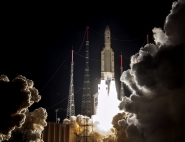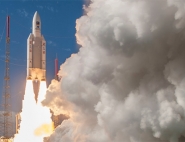Ariane 4 heritage
In the 1950s, space research was a major focus of attention in political, scientific, civil and military circles. In 1958, the International Council of Scientific Unions (ICSU) created COSPAR, the Committee on Space Research, and tasked it with coordinating and fostering the development of space research worldwide.
The first operational models of launchers came on stream in 1957 in the former Soviet Union and then 1958 in the United States. As the U.S.S.R and U.S.A pressed ahead, Europe seemed destined to remain on the sidelines. To counter this situation, European leaders adopted the idea of an organization combining the resources of the European nations. France, through CNES, put its full weight behind this project.
The European Space Agency (ESA) was formed on 20 September 1973, combining the goals of the former European Launcher Development Organization (ELDO) and European Space Research Organization (ESRO), both dating back to the early 1960s.
A priority goal
One of CNES’s main goals on its inception in 1961 was to pull together the know-how needed to build a launch vehicle—a goal it soon reached when France’s first launcher, Diamant A, lifted off on 26 November 1965, orbiting a technology capsule dubbed Asterix.
Diamant A was derived from the military Pierres Précieuses (Gemstones) programme, which comprised 5 test vehicles (Agathe, Topaze, Emeraude, Rubis and Saphir).
First launch of Diamant-A on 26 November 1965. Credits: CNES.
It was built under a cooperation agreement signed in 1962 between CNES and DMA, the French ministerial office for defence procurement, to develop a civil launcher. The 4 test flights were a success and Diamant B, the operational version, came on stream in 1970.
With 10 successful flights out of 12, the Diamant programme marked a great achievement for France, making it the 3rd nation to attain spacepower status after the Soviet Union and the United States. The experience thus acquired by CNES enabled it to propose a plan to ESA to develop a new and larger launcher with more lift capacity, paving the way for the Ariane programme.
Birth of the programme
Meeting at a space conference in Brussels, 10 European nations—among them France—decided on 31 July 1973 to build a satellite launcher code-named L III S (for 3rd-generation substitute launcher), better known as Ariane. Their affirmed objective was to give Europe its own independent space launch capability.
Credits: CNES.
The programme was led and funded by ESA, which tasked CNES’s Launch Vehicles Directorate (DLA) with project development and engineering. DLA’s key role in managing the Ariane programme was made possible by the previous military funding for Diamant.
France thus provided nearly two-thirds of the programme’s funding, with a commitment to making up any budget deficits, and a 100-strong team was put to work on Ariane.




